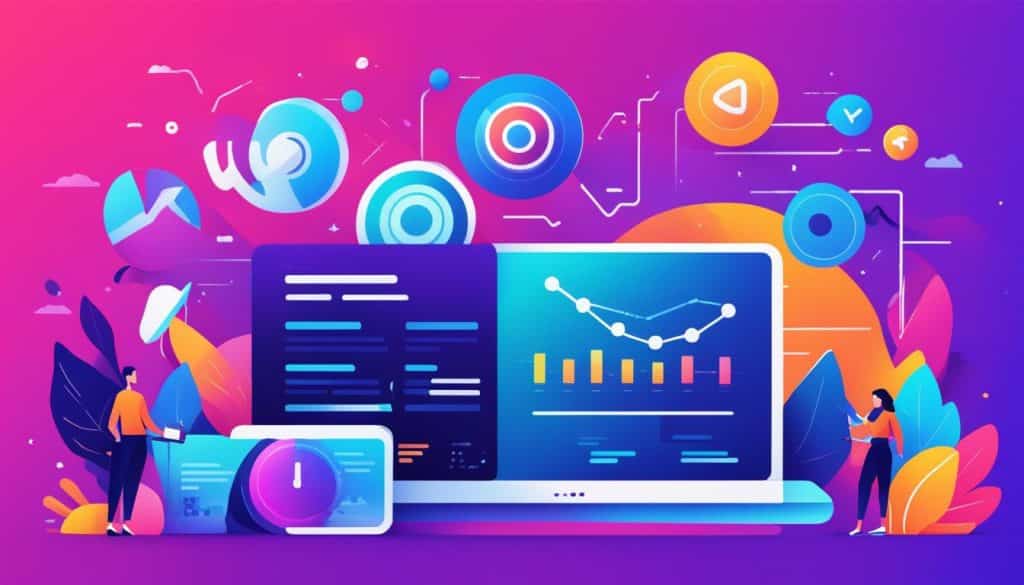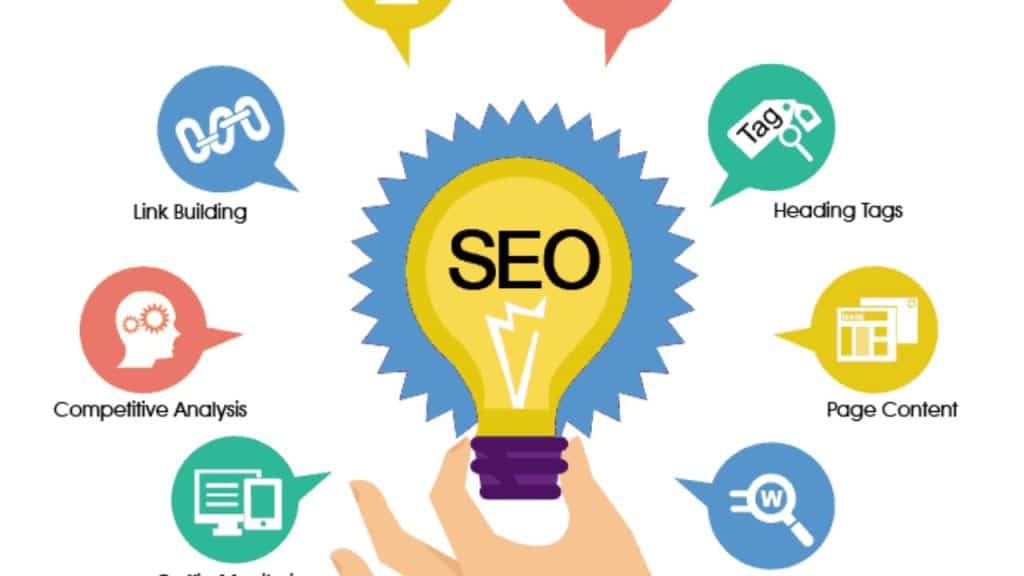Improving your website’s performance and driving more traffic starts with content optimization. By using SEO best practices and on-page optimization techniques, you can make your site more visible. This attracts your target audience. Here, we’ll look at the importance of content optimization and share nine strategies to improve your website’s content and rankings.
Key Takeaways:
- Content optimization is key to better search engine visibility and attracting the right traffic.
- Doing thorough keyword research and using website optimization techniques makes your content more effective.
- Meta tags, header tags, and a clear website content strategy are vital for content optimization.
- Creating SEO-friendly content and optimizing your website’s structure help improve search engine rankings.
- Knowing search engine optimization ranking factors is essential for a successful content optimization strategy.
What is Content Optimization?
Content optimization is about making your content better to reach your goals. It’s about optimizing for search engines, social media, sales enablement, and conversions. The goal is to tweak your content to effectively achieve your objectives.
To succeed in content optimization, you must do thorough keyword research. This helps you understand what your target audience is looking for. By finding relevant keywords, you can use them in your content.
On-page optimization is critical in content optimization. Optimizing headings, meta tags, and URL structure helps search engines understand your content better.
Content optimization also means tailoring your content for social media. You need to create engaging and shareable content that connects with your target audience and boosts social media engagement.
Sales enablement is another important part of content optimization. By creating content that addresses your audience’s pain points and needs, you provide valuable information that aids the sales process.
Ultimately, content optimization aims to attract the right audience, engage them well, and drive conversions. By refining your content to meet your audience’s interests and needs, you can maximize its impact and effectiveness.

Key points:
- Content optimization involves refining your content to achieve your goals
- It includes optimizing your content for search engines, social media, sales enablement, and conversions
- Keyword research and on-page optimization are key for effective content optimization
- Content optimization aims to attract the right audience, engage them, and drive conversions
“Content optimization is the key to ensuring that your content reaches and engages your target audience effectively.”
Why Does Content Optimization Matter?
Content optimization is vital for your digital strategy. It helps your website’s ranking, traffic, and performance. Let’s see why it’s important and how it helps you reach your goals.
Saving Time and Money
Remember, time is money! Optimizing your content early saves resources. It boosts your chances of ranking well on search engines. This attracts organic traffic and helps you achieve your goals more efficiently.
Increasing Ranking and Website Traffic
An optimized content strategy makes your website more visible. It attracts more visitors. By using effective optimization techniques, you align your content with search engine ranking factors. This includes relevant keywords, meta tags, and header tags. It improves your search engine results, driving more website traffic.
Reoptimization for Ongoing Performance
Content optimization is an ongoing process. Search engine algorithms and user behavior change. It’s important to regularly reoptimize your content to keep its performance. By analyzing data and refreshing your content, you stay competitive online.
Reaching Your Target Audience
Your content should speak to your target audience. Content optimization helps you understand their needs and preferences. By delivering valuable and relevant content, you build trust and connections. This encourages engagement with your audience.

| Benefits of Content Optimization | |
|---|---|
| Increased website ranking on search engines | Improved visibility and organic traffic |
| Saves time and resources | Enhanced efficiency in achieving goals |
| Opportunity for content reoptimization | Consistent performance over time |
| Targeted content for your audience | Higher engagement and conversions |
9 Content Optimization Strategies
Maximizing your website’s performance is key. Effective content optimization strategies are essential. They help increase your site’s visibility and attract more visitors. Here are nine important strategies to boost your site:
1. Strategic Keyword Usage
Keywords are vital for content optimization. Use relevant keywords in your content to rank better in search engines. Make sure your keyword use is natural and fits your content well.
2. Optimize Meta Descriptions and Title Tags
Meta descriptions and title tags are important for on-page optimization. Write compelling meta descriptions that summarize your content and include keywords. Use relevant keywords in your title tags to improve your search engine ranking.
3. Ensure Technical SEO Compliance
Technical SEO is critical for optimizing your content. Regular site audits help ensure your site meets technical standards. Use tools like Google PageSpeed Insights to improve your site’s speed and crawlability.
4. Create Internal Links to Relevant Content
Internal linking boosts your site’s structure and SEO. Add internal links to related content on your site. This enhances user experience and helps search engines understand your site better.
5. Build Topic Clusters
Organizing your content into topic clusters improves your site’s structure and rankings. Create pillar content that covers a broad topic and links to related subtopics. This helps search engines understand your content’s relevance and context.
6. Refresh Existing Content
Updating existing content is a time-saving way to optimize. As Google algorithms change, refreshing your content can help you maintain or regain top rankings. Analyze your content, update it with fresh information, and include relevant keywords.
7. Improve Website User Experience
Enhancing your website’s design and structure is key to content optimization. Consider factors like site navigation, page loading speed, and mobile responsiveness. A user-friendly site encourages visitors to stay longer and explore more.
8. Leverage On-Page Optimization Techniques
On-page optimization includes various techniques to boost your content’s visibility. Techniques include optimizing header tags, using descriptive alt attributes for images, and structuring your content with subheadings. Following these best practices can improve your content’s SEO performance.
9. Incorporate Effective Meta Descriptions and Title Tags
Meta descriptions and title tags are critical for attracting search engine users. Craft compelling meta descriptions that summarize your content and include target keywords. Optimize your title tags with relevant keywords to improve your content’s visibility in search engine results.

By using these content optimization strategies, you can make your site better. This means more people will visit your site and stay longer. You can do this by using keywords wisely, making your titles and descriptions better, and creating topic clusters.
It’s also important to update your content regularly. This keeps your site fresh and interesting. Always check how well your changes are working to keep improving.
Use Keywords Strategically
Using keywords the right way is key to making your content better. Put relevant keywords in the intro paragraph, headers, title, meta description, and page URL. This helps your site show up more in search results.
But don’t overdo it. Too many keywords can make your content hard to read. Make sure your keywords fit naturally into your writing.
Optimizing the Intro Paragraph
The intro paragraph is your chance to grab readers’ attention. It should give a quick idea of what your content is about. Using a keyword here helps search engines and readers alike.
“By including a keyword in your intro paragraph, you can entice your readers and make it clear from the start that your content is what they’re looking for.”
Major Headers that Stand Out
Headers like H1 and H2 tags help both search engines and readers. They show the structure of your content. Using keywords in these tags helps search engines understand your content better.
It also makes your content easier to navigate. This improves the user experience.
Title, Meta Description, and Page URL
The title, meta description, and page URL are important for your site’s visibility. Using the right keywords in these areas can help your site rank higher. It also makes your content more appealing to users.
For the title, make it short and to the point. Include your main keyword. This tells both search engines and users what your content is about.
In the meta description, naturally include your keyword. This should make users want to click on your content. It’s a brief summary that highlights the value of your content.
Lastly, your page URL should be short and include your keyword. A clear URL helps both search engines and users understand your page’s content.
Striking a Balance
While using keywords is important, don’t overdo it. Too many keywords can hurt your site’s ranking. It can also make your content hard to read.
Instead, focus on creating valuable content. Use keywords naturally to improve your site’s visibility. This way, you can rank higher in search results.
Include Meta Descriptions and Title Tags
To make your content better and more visible in search engines, you need to add meta descriptions and title tags. This part talks about why these are key for on-page SEO and making your content better.
Meta Descriptions:
Meta descriptions give a quick summary of your content. They show up below the title tag on search engine pages. They’re important for getting people to click on your link.
By making your meta descriptions interesting and full of keywords, you can get more clicks. This helps your content get seen more.
Example: If you’re looking for expert tips on content optimization, our guide will help you boost your search engine ranking and drive more organic traffic to your website.
Title Tags:
Title tags show the title of a web page. They’re the headline in search results and browser tabs. Making your title tags good with keywords and interesting is key.
It helps search engines know what your content is about. It also makes people more likely to click on your link.
By using meta descriptions and title tags that match your content and are good for Search Engine Optimization, you can make your content more visible. This can bring in more visitors and help you reach your marketing goals.

Ensure Your Site is Technically Sound
Technical optimization is key for content success. It makes sure your website meets search engine standards. Use Google PageSpeed Insights to check your site’s speed and find any problems. Also, make sure your site is easy for search engines to crawl and index.
Technical SEO helps your site be seen more and work better for users. Focus on a few important areas:
- Website Speed: A slow site hurts user experience and SEO. Use Google PageSpeed Insights to find ways to speed it up.
- Mobile-Friendliness: With more people using mobiles, make sure your site works well on them. Good mobile design improves user experience and mobile search rankings.
- Indexing and Crawlability: Help search engines find and index your site. Use sitemaps, optimize robots.txt, and meta tags to help.
- Usability: A site that’s easy to use is good for visitors and search engines. Focus on navigation, clear structure, and simple URLs.
- Security: Good security, like SSL certificates, protects user data and boosts rankings.
By focusing on technical SEO, you make your site better for performance, accessibility, and crawlability. This helps your content reach more people and rank higher in search results.
Technical Optimization Checklist
| Area of Focus | Optimization Actions |
|---|---|
| Website Speed | Analyze load times using tools like Google PageSpeed Insights and optimize images, enable caching, minify CSS and JavaScript files, and leverage browser caching. |
| Mobile-Friendliness | Ensure responsive design, test on various devices, and optimize font sizes and button placements for mobile users. |
| Indexing and Crawlability | Submit a sitemap, optimize the robots.txt file, use relevant meta tags, and fix broken links. |
| Usability | Ensure easy navigation, clear site structure, readable URLs, and user-friendly interface. |
| Security | Implement SSL certificates, ensure data encryption, and regularly update security measures. |
By following this checklist, you can optimize your website technically, enhance its performance, and provide a seamless experience for your visitors, leading to improved search engine rankings.
Create Internal Links to Relevant Content
Internal linking is key for better content. External links boost your domain authority. But internal links make your site easier to navigate and help search engines understand your content better. By linking to relevant pages, you improve your SEO and help your readers.
Creating internal links guides readers to other useful pages on your site. It also tells search engines that these pages are connected and important. This can help your SEO by showing the depth and range of your content.
Here are some tips for making good internal links:
- Use descriptive anchor text: Instead of “click here,” use text that shows what the link is about. This helps both readers and search engines understand the link’s context.
- Link from high-authority pages: Linking from pages with high domain authority makes the linked pages more credible and visible. This can improve their search rankings.
- Use different anchor texts: Varying your anchor text shows search engines the different topics on your site. It also makes your content easier for readers to follow.
Here’s why internal linking is important:
“A website saw a 20% increase in organic traffic and better search rankings by using internal links. This improved its SEO and made it easier for users to find what they needed.”
Good internal linking can boost your SEO, make your site easier to use, and show off your valuable content.
Build Topic Clusters
To improve your SEO strategy and organize your content, use topic clusters. Topic clusters group your content around specific subjects. They have a main guide page and link to related topics.
Topic clusters make your site’s structure better and boost your SEO. Search engines can understand your content’s context and relevance better. This leads to higher rankings. Plus, it makes your site easier for users to navigate.
When making topic clusters, it’s important to show clear connections between the main guide and related topics. Internal linking is key here. It helps search engines see how different content on your site is connected.
Benefits of Topic Clusters
Topic clusters have many advantages:
- Improved SEO: Organizing your content around topics makes your site more focused and authoritative to search engines.
- Enhanced Content Organization: Topic clusters make your content easy to follow for both users and search engines.
- Expertise in Related Topics: By creating detailed main guides and linking to related topics, you show your expertise in your field.
- Increased Internal Linking: Linking your main guide to related topics strengthens your site’s internal linking. This can help your SEO.
Implementing topic clusters requires careful planning and a thorough understanding of your target audience’s interests and needs. By strategically organizing and linking your content, you can maximize the impact of your SEO efforts and deliver valuable information to your readers.
| Benefits of Topic Clusters | Description |
|---|---|
| Improved SEO | Organizing content around specific topics helps boost search engine rankings. |
| Enhanced Content Organization | Topic clusters create a logical structure that is user-friendly and search engine-friendly. |
| Expertise in Related Topics | Pillar content and related subtopics establish you as an authority in your field. |
| Increased Internal Linking | Linking pillar content to subtopics strengthens your site’s internal linking structure. |
Implementing topic clusters is a powerful SEO strategy that improves content organization and maximizes the impact of your internal linking efforts. By creating comprehensive pillar content and linking it to related subtopics, you can establish your site as a valuable resource to both search engines and users.
Refresh Existing Content
Content reoptimization, or content refreshes, can boost your content’s performance. As Google algorithms change and competition shifts, old content may fall in ranking. Yet, updating your content can save time and help it regain its spot on search engine results pages.
Content reoptimization means revisiting old articles and blog posts. You make changes to make them more relevant and user-friendly. This way, your content stays current with SEO best practices and industry trends.
Refreshing your content offers several SEO benefits:
- Improved Ranking: Optimizing your content can help it rank higher on search engine results pages. This boosts your website’s visibility and organic traffic.
- Time-Saving: Reoptimizing content saves time. It’s great when resources are limited or you need quick results.
- Enhanced User Experience: Refreshing content is a chance to improve your website’s user experience. Update outdated info, fix broken links, and meet your audience’s needs.
To refresh your content effectively, follow these steps:
- Perform a Content Audit: Check your content to find what needs improvement. Look for outdated info, low engagement, or declining rankings.
- Analyze Keyword Relevance: Find new or trending keywords for your content. Update your content with these keywords naturally.
- Improve Formatting and Readability: Make your content more appealing. Use better headings, paragraphs, and bullet points. Add subheadings (H3) for easier scanning.
- Update Statistics and Examples: Replace old statistics and examples with new, accurate ones. Keep all data and references current.
- Create Engaging Visuals: Add images, infographics, or videos to make your content more engaging and visually appealing.
- Optimize Meta Tags: Update meta descriptions and title tags to match your refreshed content. Use relevant keywords to attract search engine users and improve click-through rates.
- Include Internal and External Links: Add new internal links to other relevant pages and external links to authoritative sources. This enhances user experience and adds value to your content.
- Promote Your Refreshed Content: After optimizing your content, promote it through social media, email newsletters, or outreach to industry influencers.
Regularly refreshing your content maximizes its value and keeps it competitive in the digital world.
Conclusion
In today’s digital world, content optimization is key for better website performance and search engine visibility. By using the strategies from this article, you can improve user engagement, attract organic traffic, and meet your marketing goals.
Creating SEO-friendly content is vital. Use strategic keywords to make your content more visible on search engine results pages. This attracts more targeted visitors to your site.
Optimizing meta tags, like meta descriptions and title tags, is also important. Craft compelling, keyword-rich meta tags to boost click-through rates and entice users to visit your site.
Building internal links to relevant content is essential. It helps search engines understand your site’s structure and topics. It also enhances the reader experience by providing more valuable resources.
FAQ
What is content optimization?
Content optimization is about making your content better to meet your goals. It means making your content work well for search engines, social media, and sales. The goal is to improve your content so it reaches your target audience better.
Why does content optimization matter?
It saves you time and money by helping your content rank better on search engines. Optimized content draws more website traffic. It also stays effective over time. By optimizing, your content reaches the right people and meets specific goals.
What are some content optimization strategies?
There are many ways to improve your site’s performance. Use keywords wisely, optimize meta descriptions and title tags, and make sure your site works well. Also, create internal links, build topic clusters, and refresh existing content. A better user experience also helps.
How should I use keywords strategically?
Using keywords well is key. Put them in the intro, headers, title, meta description, and URL. But don’t stuff them. Make sure they fit naturally with your content.
Why are meta descriptions and title tags important for content optimization?
Meta descriptions and title tags are vital for on-page SEO. They give a quick summary of your content. By using target keywords and engaging language, you can get more clicks and visibility.
How can I ensure my site is technically sound for content optimization?
Technical optimization is essential. Make sure your site meets search engine standards. Check your site’s speed and fix any issues. Also, ensure it’s indexed and crawlable.
Why should I create internal links to relevant content?
Internal linking is important. It helps users and search engines understand your site better. Linking to relevant content improves SEO and helps readers.
What are topic clusters and how do they contribute to content optimization?
Topic clusters organize your content around topics. Create a main guide and link related topics to it. This improves your site’s structure and SEO, helping search engines and users.
How can I refresh existing content for content optimization?
Refreshing existing content is a smart move. It helps your content stay relevant as algorithms and competition change. Updating your content can save time and boost your rankings.





